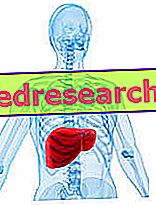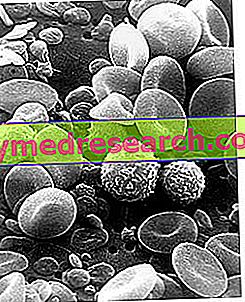Generality
Sheehan syndrome is a rare complication that can affect women during or after childbirth .

The condition occurs due to an ischemic pituitary necrosis, generally secondary to a loss of a potentially lethal amount of blood ( uterine haemorrhage ) or to a severe lowering of arterial pressure ( hypotension ). The reduced blood supply and the lack of oxygen that follow from these events can damage the pituitary gland (a small gland located at the base of the brain), which can no longer produce enough hormones. In Sheehan syndrome, a state of pituitary insufficiency ( hypopituitarism ) is thus created.
After the birth of the child, the lack of the milk supply and the missed recovery of menstruation (post-gravidar amenorrhea) are the most common presentation symptoms.
The diagnosis of Sheehan syndrome requires the performance of neuroradiological examinations and the determination of pituitary hormones, in basal conditions and after various types of stimulus tests. These investigations aim to determine which pituitary hormones are deficient and whether they need to be replaced pharmacologically.
Treatment of Sheehan syndrome usually involves hormone replacement therapy, which can be modulated on the basis of the hormones that the woman lacks.
What's this
Sheehan's syndrome consists of an ischemic pituitary necrosis, caused by hypovolemia and a state of shock, which occurs during or immediately after birth.
Also called postpartum hypopituitarism, this condition is characterized by reduced or absent secretion of one or more hormones by the pituitary gland (or pituitary gland). The presentation of Sheehan syndrome varies from one patient to another (clinical manifestations range from non-specific symptoms to coma). Usually, no milk secretion ( disease ) appears and the patient may complain of fatigue, amenorrhea, cold intolerance and loss of pubic and axillary hair.
Most patients have mild symptoms, so Sheehan syndrome is not diagnosed and treated for a long period of time.
Causes
Sheehan syndrome is caused by severe blood loss or extremely low blood pressure during or after childbirth. These factors can be particularly harmful to the pituitary gland. In fact, during pregnancy, the latter increases its physiological volume. In Sheehan syndrome, oxygen deficiency secondary to hypovolemia or hypotensive crisis damages the tissue that normally produces pituitary hormones and the gland undergoes hypofunction.
Rarely, the clinical picture of Sheehan syndrome can be observed without massive bleeding or after a normal birth.
Sheehan syndrome: pituitary hormones and possible consequences
The hormones secreted by the pituitary gland and those produced by their target organs control metabolism, fertility, blood pressure, breast milk production and many other vital processes. Therefore, a lack of these hormones can cause problems throughout the body.
To better understand how the damage to the pituitary gland is implicated in Sheehan syndrome, we must remember some notions about the hormones produced by it:
- ACTH (adrenocorticotropic hormone) : stimulates the adrenal glands to produce cortisol. ACTH deficiency results in cortisol deficiency due to hypoactivity of the adrenal glands.
- Oxytocin : hormone necessary for labor, delivery (stimulates contractions) and breastfeeding.
- PRL (prolactin or lactotropic hormone) : responsible for milk production by mothers after childbirth. Prolactin deficiency is associated with the reduction or total absence of lactation. In Sheehan syndrome, milk production does not occur, as pituitary necrosis causes the destruction of galactotropic cells responsible for prolactin production (PRL).
- TSH (thyroid-stimulating or thyrotropic hormone) : regulates the production of hormones by the thyroid gland. The lack or deficiency of the thyroid stimulating hormone affects the thyroid activity (in particular, on the production of T3 and T4), resulting in hypothyroidism.
- LH (luteinizing hormone) and FSH (follicle stimulating hormone) : they control fertility in both sexes (ovulation in women, production of sperm in men) and stimulate the secretion of sex hormones from ovaries and testicles (estrogen and progesterone in women; testosterone in women). 'man). In Sheehan syndrome, post-gravidar amenorrhea occurs due to ischemic involvement of the area responsible for the production of pituitary gonadotropic hormones, with lack of LH and FSH secretion.
- GH (growth hormone or somatotrope) : it is necessary for development in children (bones and muscle mass), but it has effects on the whole organism throughout life. In adults, growth hormone deficiency can lead to lack of physical energy, changes in body composition (increase in fat and decrease in muscle mass) and increased cardiovascular risk.
- ADH (antidiuretic hormone or vasopressin) : helps maintain a normal water balance. The lack of antidiuretic hormone (or vasopressin) affects the kidneys and can result in diabetes insipidus. This condition typically occurs with excessive thirst, diluted urine and frequent urination (polyuria), particularly during the night.
Risk factors
Any condition that increases the chance of experiencing severe blood loss (haemorrhage) or low blood pressure during childbirth can increase the risk of experiencing Sheehan syndrome.
The main risk factors include twin pregnancies and placental complications .
In women suffering from severe postpartum haemorrhage, other conditions that could play a role in the pathogenesis of Sheehan syndrome include physiological hypertrophy of the pituitary gland in pregnancy (so the pituitary gland requires more blood to support its activity ), disseminated intravascular coagulation and autoimmunity.
To know
Postpartum uterine hemorrhage is a rather rare complication and it is necessary to consider that the Sheehan syndrome occurs even less frequently. Both risks are greatly reduced with the care and monitoring of women during labor and delivery.
It should also be noted that Sheehan syndrome is not common in industrialized nations, largely due to improved obstetric care and the availability of rapid blood transfusion. The risk remains, however, for women in developing countries.
Symptoms and Complications
The symptoms of Sheehan syndrome typically occur gradually, over a period of several months or even years. Other times, the signs appear immediately after the birth, as happens, for example, with the inability to breastfeed, or occur with an abrupt onset hypopituitarism .
The manifestations of Sheehan syndrome occur due to the hormone deficiency produced by the pituitary gland . In addition to producing breast milk, the effects of this dysfunction affect the thyroid and adrenal activity and the menstrual cycle.
The deficiency or absence of one, many or all of the pituitary hormones can lead to major changes in the body (except for oxytocin and prolactin).
The clinical picture of Sheehan syndrome can be clinically evident (ie hormonal deficiency is clinically evident) or latent (it occurs only in certain situations, such as severe stress, or is detected only through some specific hormonal tests).
Sheehan syndrome: how it occurs
Sheehan syndrome can produce various signs and symptoms, which depend on what the missing or deficient pituitary hormone is and include:
- Difficulty or inability to breastfeed;
- Absence of menstrual flows (amenorrhea) or infrequent menstruation (oligomenorrhea);
- Decrease in blood pressure values;
- Low levels of sugar (glucose) in the blood (hypoglycemia);
- Irregular heart beat;
- Difficulty concentrating and drowsiness;
- Abdominal pain;
- Fatigue;
- Generalized swelling;
- Cold intolerance;
- Weight gain or, on the contrary, weight loss.
It should be noted that, for many women, the symptoms of Sheehan syndrome are non-specific and are often attributed to other situations (for example: fatigue can be interpreted as a consequence of becoming a mother). There are cases, then, in which it is possible that no disorders appear at all: the extent of the symptoms of Sheehan syndrome are related, in fact, to the extent of damage to the pituitary gland. Postpartum hypopituitarism can therefore affect the production of one or more hormones.
Some women live for years without knowing that their pituitary is not working properly. However, extreme physical stress, such as severe infection or surgery, can suddenly trigger thyroid or adrenal insufficiency .
Complications
Pituitary hormones control many aspects of metabolism, so Sheehan syndrome can cause a number of problems, including:
- Adrenal crisis (a serious condition in which the adrenal glands produce too little cortisol hormone);
- Low blood pressure (hypotension);
- Reduction of plasma sodium levels;
- Menstrual irregularities;
- Infertility;
- Weakness and reduced tolerance to effort.
Adrenal crisis: a life-threatening situation
The most serious complication of Sheehan syndrome is the adrenal crisis, that is a sudden and potentially lethal state, in which they occur in succession: extremely low blood pressure, shock, coma and death.
Diagnosis
The diagnosis of Sheehan syndrome can be complex. Many of the symptoms overlap, in fact, with those of other pathological conditions.
The diagnosis of Sheehan syndrome is formulated on the basis of the symptoms presented by the patient and on the outcome of laboratory tests (hormonal dosages) and diagnostic tests for images performed on the pituitary gland.
More in detail, the investigations necessary to establish the presence of Sheehan syndrome include:
- History . In collecting information related to the patient's medical history, it is important to mention any complications of childbirth, regardless of when the child was born, as disorders related to Sheehan syndrome may start late. Other useful anamnestic data to report to the doctor are amenorrhea and the lack of milk production, two key signs of Sheehan syndrome.
- Blood and urine tests . Laboratory tests can be used to check whether the levels of hormones secreted by the pituitary gland and their target organs fall within the reference range (eg, free thyroxine, TSH, prolactin, LH, FSH and testosterone in men or estradiol in women). If Sheehan syndrome is suspected, a pituitary hormone stimulation test may also be required to assess the response of the gland. This test is generally carried out after consulting a doctor specialized in hormonal disorders (endocrinologist). Hormonal dosages are performed on the blood and sometimes on the urine.
- Neuroradiological examinations . To check the size of the pituitary gland or to exclude other possible conditions that could justify the symptomatology (like a pituitary tumor), the patient could be subjected to imaging tests. In the majority of patients with Sheehan syndrome, high-resolution computed tomography (CT) and magnetic resonance imaging (MR) with contrast medium demonstrate a secondary empty saddle syndrome.
Treatment
Treatment of Sheehan syndrome usually involves the replacement of deficient hormones with synthetic compounds. The goal is to minimize the symptoms (ie the patient should not feel the consequences of hormonal deficiency) and allow the conduct of a normal life.
Hormone replacement therapy is adapted to each individual case. For this reason, the patient with Sheehan syndrome should be regularly monitored by her doctor after starting treatment.



